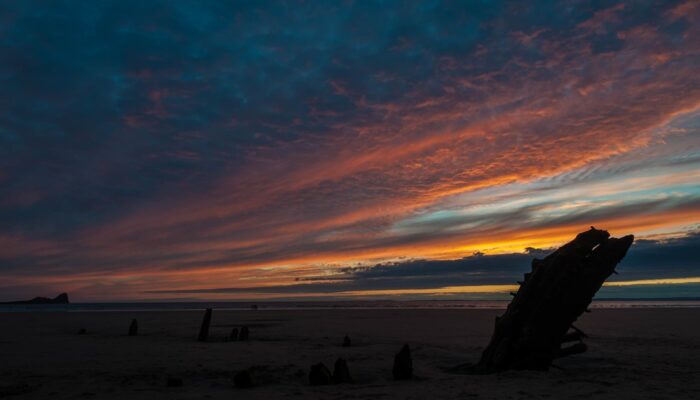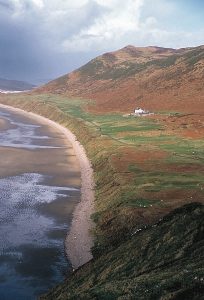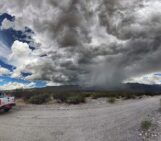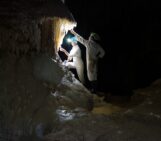
The Gower Peninsula in South Wales, United Kingdom, is a spectacular site to view a sunset. However, to geologists, the shore is also a prime spot to find artifacts from Earth’s ancient and recent past.
“The limestone coastline is dotted with caves that are rich in Quaternary flora and fauna,” said Mike Smith a visiting researcher at Plymouth University (UK) and photographer of this featured image. “Including the famous Red Lady of Paviland, the oldest known ceremonial burial in Western Europe, at 30,000 years before present.”
The peninsula is also known for its “dramatic and visible evidence of climate change over a range of temporal scales,” according to Smith.

A solifluction terrace on the Rhossili Bay in the Gower Peninsula.
Credit: Stephen Codrington. Planet Geography 3rd Edition, 2005 (distributed via Wikimedia Commons).
For example, at the peak of Earth’s most recent glacial period, when the northern ice sheets had made their greatest advances southward, the Gower Peninsula was one of the southern most regions overcome by ice.
Though the last glacial period ended more than 11,00 years ago, you can find evidence of this tundra environment today, if you know what to look for.
For instance, much of the Peninsula’s coastlines are lined by small steeply sloping ridges, separating the coast’s green hillslopes from its sandy beaches. These structures are often referred to as solifluction terraces, and are formed when frozen ground thaws, causing soil, rock and other debris to move downslope.
Additionally, the Gower Peninsula is also host to remnants of our very recent history.
Pictured above are the remains of the shipwrecked Helvetica, a cargo vessel from the late 19th century that had been transporting 500 tons of timber before meeting its untimely end on the banks of Worm’s Head, a small rocky island just a few kilometres long, visible from the peninsula’s shores.
On 1 November, 1887, strong gales just off the coast had taken a hold of the ship, leaving it unable to dock at Swansea Harbour. Instead, the forceful winds blew the vessel into the sandbank of Helwick Sands and then dragged the ship to its final resting place, the shores of Worm’s Head. Helvetica’s captain and crew were forced to abandon ship, and after its cargo was relocated and salvageable parts stripped away, the ship settled deep into the sand.
“The Helvetica is now permanently buried in the beach on a coastline that is bordered by extensive sand dune systems,” remarks Smith. With each year since, the Atlantic has reclaimed more of the ship, and now just the bare bones of the wreckage remain.
References
Helvetica (Explore Gower)
Hall, Adrian. Cairngorm Landscapes [Edinburgh, Scotland], Solifluction, 2002



